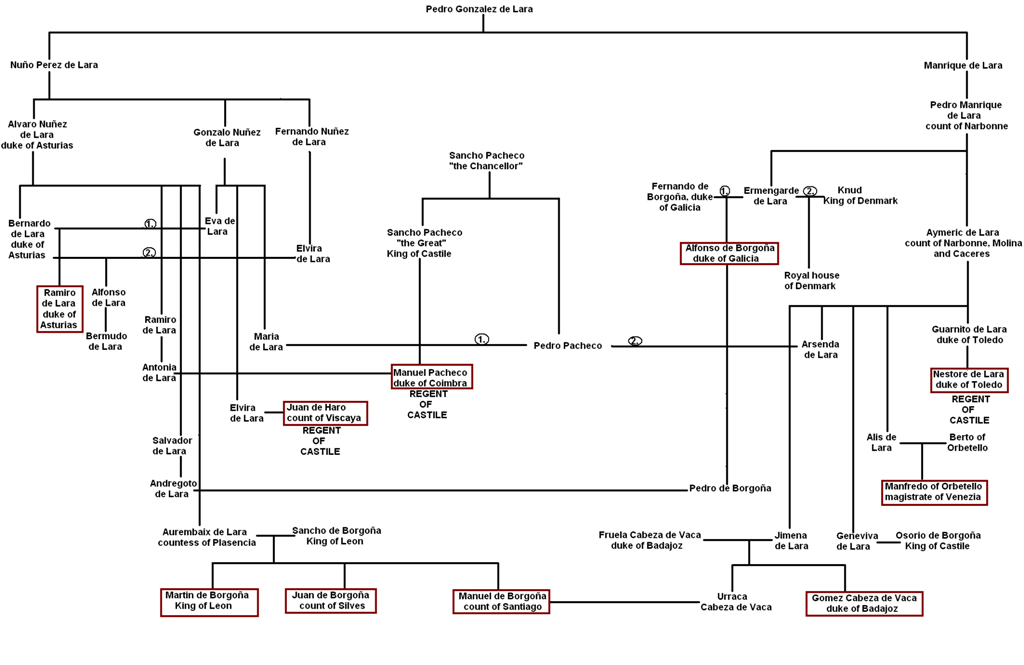The succession in Salamanca proved to be another of the turning points in king Sancho’s reign. The duke of Salamanca’s son, Sancho de la Cueva, was excommunicated, and thus the de la Cueva family had no legal heir to the title. Through spy master Jose Pacheco’s marriage to the duke’s daughter, however, Manuel was born heir presumptive. Historians agree that the legal term was first adopted in this circumstance. An heir presumptive is a conditional heir who is currently in line to inherit but could be displaced at any time in the future. And, in fact, any son born to the count of Zamora would be the heir apparent, thus removing any Pacheco legal claims to the duchy of Salamanca. And that was the case, with the count’s wife giving birth to the twin brothers Domingo and Ignacio. Manuel Pacheco was now third in line to inherit the title, and his position would slip even further down the line should the two reach maturity and produce heirs of their own.
The mysterious deaths of the two de la Cueva brothers in 1238 was thought to have been linked in some way to Jose Pacheco’s ambition to obtain Salamanca for the crown of Castile. Jose, the king’s son and heir, was influencing Castilian politics more than his role of spy master entitled him to. Although never proved, it is considered that he hired the assassins to resolve the Salamanca affair. The dukes, de Laras, de Borgona and de Quintana, were growing rebellious not because of the king, whose rule was considered fair and efficient, but because of the heir to the throne.
As spy master, Jose probably had a role in the death of his own son, Sancho, only 5 years old, in 1239. According to the diaries of one of his close friends, discovered in the 18th century, Jose Pacheco desired a centralized state, and he felt that having more than one heir would inevitably lead to a struggle for power inside the royal family. The king, now 40 years of age, started to question his son’s ability to rule the kingdom. While leaving Jose with no lands, he granted his grandson, Manuel, the duchy of Coimbra, consisting of the provinces of Castelo Branco and Coimbra, the traditional lands of the Pacheco family. It was probably this last action that deeply angered Jose, and led to the king’s murder, in December. Jose, again suspected but never proved to be behind the assassination, now held all of his father’s titles: king of Castile, duke of Toscana and Castilla, count of Toledo, Badajoz, Porto, Soria, Alcacer do Sal, Valladolid and Cuenca.
The mysterious deaths of the two de la Cueva brothers in 1238 was thought to have been linked in some way to Jose Pacheco’s ambition to obtain Salamanca for the crown of Castile. Jose, the king’s son and heir, was influencing Castilian politics more than his role of spy master entitled him to. Although never proved, it is considered that he hired the assassins to resolve the Salamanca affair. The dukes, de Laras, de Borgona and de Quintana, were growing rebellious not because of the king, whose rule was considered fair and efficient, but because of the heir to the throne.
As spy master, Jose probably had a role in the death of his own son, Sancho, only 5 years old, in 1239. According to the diaries of one of his close friends, discovered in the 18th century, Jose Pacheco desired a centralized state, and he felt that having more than one heir would inevitably lead to a struggle for power inside the royal family. The king, now 40 years of age, started to question his son’s ability to rule the kingdom. While leaving Jose with no lands, he granted his grandson, Manuel, the duchy of Coimbra, consisting of the provinces of Castelo Branco and Coimbra, the traditional lands of the Pacheco family. It was probably this last action that deeply angered Jose, and led to the king’s murder, in December. Jose, again suspected but never proved to be behind the assassination, now held all of his father’s titles: king of Castile, duke of Toscana and Castilla, count of Toledo, Badajoz, Porto, Soria, Alcacer do Sal, Valladolid and Cuenca.






